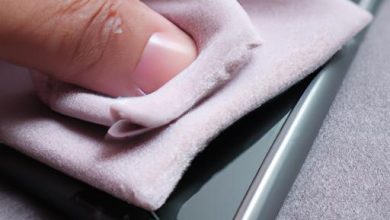Harman Kardon Soundsticks 4 Review: Unleashing the Power of Crystal Clear Sound

When it comes to delivering an immersive audio experience, Harman Kardon has always been at the forefront of innovation. Their latest offering, the Harman Kardon Soundsticks 4, is no exception. In this comprehensive review, we will dive deep into the world of Soundsticks 4 and explore why it has become a crowd favorite.
Introduction to Harman Kardon Soundsticks 4
Harman Kardon Soundsticks 4 is a visually stunning 2.1 speaker system that combines elegant design with outstanding sound quality. With its transparent dome-shaped satellite speakers and powerful subwoofer, this masterpiece not only enhances your auditory senses but also adds a touch of sophistication to your living space.
A Brief Overview of the Product and its Features
The Soundsticks 4 boasts an impressive set of features that set it apart from the competition. Let’s take a closer look:
-
Iconic Design: The transparent satellite speakers with the mesmerizing LED illumination create a captivating visual experience, making the Soundsticks 4 a true showstopper.
-
Powerful Sound Performance: Equipped with 100 watts of amplification and a 6-inch down-firing subwoofer, the Soundsticks 4 delivers deep bass and crystal clear audio, ensuring every note and beat are heard with precision.
-
Wireless Bluetooth Connectivity: Say goodbye to tangled wires! The Soundsticks 4 allows easy connectivity to your devices via Bluetooth, providing seamless streaming without compromising on audio quality.
-
User-Friendly Controls: The intuitive touch controls on the satellite speakers allow you to adjust volume, mute, and even control Bluetooth connections effortlessly.
-
Versatile Compatibility: Whether you’re a music lover, gamer, or movie enthusiast, the Soundsticks 4 is compatible with various devices, including laptops, smartphones, gaming consoles, and televisions.
The Importance of Reading Reviews Before Purchasing
Before investing your hard-earned money in any product, it’s crucial to gather insights from real users. Reviews provide valuable information about the pros, cons, and overall performance of a product. When it comes to making an informed decision about purchasing the Harman Kardon Soundsticks 4, reading reviews becomes even more vital.
Now that we have acquainted ourselves with the basics of the Soundsticks 4 and its remarkable features, let’s delve deeper into the design and build quality of this audio marvel. Stay tuned for the next section of this review to unravel the secrets behind its captivating design and sturdy construction.
Design and Build Quality
Description of the Design Elements of Harman Kardon Soundsticks 4
The design of the Harman Kardon Soundsticks 4 is a true testament to the brand’s commitment to elegance and innovation. The transparent dome-shaped satellite speakers, illuminated by captivating LED lights, create a visual spectacle that enhances any room. The sleek and minimalistic design seamlessly blends with modern aesthetics, making the Soundsticks 4 a stunning centerpiece.
Evaluation of the Build Quality and Durability
Harman Kardon has always been synonymous with top-notch build quality, and the Soundsticks 4 is no exception. Crafted with precision and attention to detail, these speakers are built to withstand the test of time. The transparent speaker enclosures are not only visually appealing but also durable, providing a sturdy foundation for the audio components within.
The subwoofer, with its down-firing 6-inch driver, is housed in a solid casing that ensures optimal performance and durability. It delivers powerful bass without any distortion, elevating your audio experience to new heights. The Soundsticks 4 is built to handle even the most demanding soundscapes, making it a reliable companion for music enthusiasts and movie lovers alike.
Comparison with Previous Soundsticks Models, if Applicable
If you’re familiar with the previous iterations of the Soundsticks series, you’ll notice that the Soundsticks 4 builds upon its predecessors’ success while introducing exciting new features. While the iconic transparent design remains a signature element, the Soundsticks 4 takes it a step further with enhanced LED illumination, creating a more mesmerizing visual experience.
In terms of build quality, the Soundsticks 4 maintains the same level of excellence as its predecessors. The attention to detail and premium materials used in its construction ensure longevity and reliability. However, the Soundsticks 4 surpasses its predecessors in terms of sound performance, offering more power and clarity.
Overall, the design and build quality of the Harman Kardon Soundsticks 4 are a testament to the brand’s commitment to delivering a product that not only sounds exceptional but also complements your living space with its stunning aesthetics. In the next section, we will explore the sound performance of the Soundsticks 4 and discover how it creates an immersive audio experience.
Sound Performance: Unveiling the Symphony of Audio Excellence
In-depth Analysis of the Sound Performance of Harman Kardon Soundsticks 4
When it comes to the Harman Kardon Soundsticks 4, it’s not just about the stunning design – the real magic lies in its exceptional sound performance. Let’s take a closer look at what this powerhouse has to offer:
Audio Clarity: A Symphony of Crisp and Clear Sound
The Soundsticks 4 delivers an unparalleled audio clarity that brings your favorite music, movies, and games to life. With its precise and detailed sound reproduction, every note and instrument is showcased with remarkable accuracy. From the delicate strumming of a guitar to the rich vocals of your favorite artist, this speaker system ensures that no detail goes unnoticed.
Deep Bass: Plunging into the Depths of Musical Pleasure
One of the standout features of the Soundsticks 4 is its ability to produce deep and impactful bass. The 6-inch down-firing subwoofer unleashes a low-end rumble that adds depth and dimension to your audio experience. Whether you’re listening to bass-heavy tracks or watching action-packed movies, the Soundsticks 4 delivers a powerful bass response that will make you feel every beat in your core.
Overall Sound Quality: A Harmonious Balance of Frequencies
The Soundsticks 4 strikes a perfect balance between different frequencies, ensuring a well-rounded sound experience. The satellite speakers and subwoofer work in harmony, creating a cohesive audio output that encompasses the entire frequency spectrum. From the crisp highs to the punchy mids and the rumbling lows, every aspect of the sound is beautifully reproduced, immersing you in a sonic wonderland.
Comparison with Other Similar Speakers in the Market
In a market flooded with numerous speaker options, the Harman Kardon Soundsticks 4 stands out as a true contender. Let’s compare it with some of its competitors to understand why it reigns supreme:
Sound Quality
When it comes to sound quality, the Soundsticks 4 outshines many of its rivals. Its precise and detailed audio reproduction sets it apart, ensuring an immersive listening experience that is hard to match. While other speakers may emphasize certain frequencies, the Soundsticks 4 offers a balanced sound signature that caters to a wide range of musical genres and multimedia content.
Design and Aesthetics
In terms of design, the Soundsticks 4’s transparent satellite speakers and captivating LED illumination make it a visual masterpiece. Many other speakers on the market lack the same level of elegance and sophistication that the Soundsticks 4 exudes, making it a stunning addition to any home or office space.
Connectivity Options
With its wireless Bluetooth connectivity, the Soundsticks 4 provides seamless and hassle-free pairing with various devices. This sets it apart from speakers that rely solely on wired connections, giving you the freedom to stream your favorite content without the limitations of cords and cables.
As we’ve explored the extraordinary sound performance of the Soundsticks 4 and compared it to other speakers in the market, it’s clear that this audio gem truly stands in a league of its own. In the upcoming section, we will delve into the connectivity options offered by the Soundsticks 4, allowing you to unleash the full potential of this remarkable speaker system. So, stay tuned for more!
Connectivity Options
Overview of Available Connectivity Options for Harman Kardon Soundsticks 4
The Harman Kardon Soundsticks 4 offers a range of connectivity options, ensuring seamless integration with your favorite devices. Let’s take a closer look at the available options:
-
Wired Connection: The Soundsticks 4 features a 3.5mm audio input, allowing you to connect it to a wide array of devices such as computers, laptops, and gaming consoles. This traditional wired connection ensures a stable and reliable audio transmission, delivering high-quality sound without any lag.
-
Wireless Bluetooth Connectivity: Say goodbye to the hassle of cables and cords. With its built-in Bluetooth technology, the Soundsticks 4 allows you to connect wirelessly to your smartphones, tablets, and other Bluetooth-enabled devices. Simply pair your device with the speakers, and you can enjoy your favorite music, podcasts, or movies without the limitations of physical connections.
Discussion of Wired and Wireless Connections
Both wired and wireless connections have their own advantages and considerations. Let’s explore them in more detail:
-
Wired Connections: If you value a consistent and uninterrupted audio experience, the wired connection option is your go-to choice. It ensures a stable connection without any interference or latency issues, making it ideal for activities that demand precise synchronization, such as gaming or professional audio editing. Additionally, using a wired connection eliminates the need for battery charging or the dependency on Bluetooth connectivity.
-
Wireless Connections: The wireless Bluetooth connectivity of the Soundsticks 4 offers unparalleled convenience and flexibility. It allows you to move around freely without being tethered to the speakers, making it perfect for social gatherings or simply enjoying music from different corners of your room. With Bluetooth technology, you can easily switch between devices and control the audio playback from a distance, giving you the freedom to multitask without compromising on sound quality.
Evaluation of the Ease of Connecting Devices to the Speakers
Connecting your devices to the Soundsticks 4 is a breeze, regardless of whether you choose the wired or wireless option. The speakers come with clear and straightforward instructions, making the setup process hassle-free. For wired connections, simply plug in the 3.5mm audio cable to the audio input of the speakers and your device. For wireless connections, activate the Bluetooth pairing mode on the Soundsticks 4, locate the speakers in your device’s Bluetooth settings, and establish a connection. The Soundsticks 4 is designed to quickly and effortlessly pair with your devices, ensuring a seamless and hassle-free experience from the moment you set it up.
Now that we have explored the various connectivity options of the Harman Kardon Soundsticks 4, let’s move on to the next section to uncover the user-friendly features that make this audio system a true delight to use.
User-Friendly Features
When it comes to choosing the perfect speaker system, convenience and ease of use are paramount considerations. Harman Kardon Soundsticks 4 excels in this aspect, offering a range of user-friendly features that enhance the overall listening experience. Let’s dive into the details:
Examination of the User-Friendly Features of Harman Kardon Soundsticks 4
-
Intuitive Touch Controls: The Soundsticks 4 is equipped with touch-sensitive controls on the satellite speakers, allowing you to effortlessly adjust the volume, mute the sound, and control Bluetooth connections with a simple touch. No more fumbling for buttons or struggling with complicated interfaces.
-
Bluetooth Connectivity: Pairing your devices with the Soundsticks 4 is a breeze, thanks to its seamless Bluetooth connectivity. Whether you want to stream music from your smartphone, tablet, or laptop, the wireless connection eliminates the hassle of wires while maintaining high-quality audio playback.
-
Wired Connectivity Options: In addition to Bluetooth, the Soundsticks 4 also offers wired connectivity options. With a 3.5mm audio input, you can connect devices that don’t support Bluetooth, ensuring compatibility with a wide range of devices.
Discussion of Any Unique or Standout Features
-
Captivating LED Illumination: One of the standout features of the Soundsticks 4 is the mesmerizing LED illumination on the satellite speakers. With its pulsating light patterns, the speakers create a visually captivating experience that adds an extra layer of ambiance to your listening environment.
-
Transparent Design: The transparent dome-shaped satellite speakers are not only visually stunning but also serve a practical purpose. The transparency allows you to witness the inner workings of the speakers, adding an element of intrigue to the overall design.
Evaluation of the Usability and Convenience for the Users
The user-friendly features of the Soundsticks 4 make it incredibly convenient to use for everyone, regardless of their technical expertise. The touch controls and intuitive interface ensure a hassle-free user experience, while the seamless Bluetooth connectivity and wired options cater to a wide range of devices. Whether you’re a tech enthusiast or a casual listener, the Soundsticks 4 offers a user-friendly interface that allows you to enjoy your favorite music, movies, and games effortlessly.
As we’ve explored the user-friendly features of the Soundsticks 4, we’ve only scratched the surface of what this remarkable speaker system has to offer. In the next section, we’ll delve into the pros and cons of the Soundsticks 4, providing a comprehensive overview to help you make an informed decision. Stay tuned!
Conclusion: Elevate Your Audio Experience with Harman Kardon Soundsticks 4
In conclusion, the Harman Kardon Soundsticks 4 is a true masterpiece that combines exceptional design, powerful sound performance, and user-friendly features. With its iconic transparent satellite speakers and captivating LED illumination, it not only delivers immersive audio but also adds a touch of elegance to any space.
When it comes to sound quality, the Soundsticks 4 excels. The 100 watts of amplification and the 6-inch down-firing subwoofer ensure a rich and balanced audio experience, allowing you to hear every detail with clarity. Whether you’re enjoying music, gaming, or watching movies, the Soundsticks 4 will transport you to a new level of audio immersion.
The wireless Bluetooth connectivity feature makes it effortless to connect your devices and stream your favorite content seamlessly. No more dealing with messy wires or sacrificing audio quality. The intuitive touch controls on the satellite speakers add convenience, allowing you to adjust volume and manage Bluetooth connections with ease.
Before making a purchase, it is essential to read reviews and gather insights from real users. The positive feedback from customers who have experienced the Soundsticks 4 is a testament to its exceptional performance and quality.
If you’re looking to elevate your audio experience, the Harman Kardon Soundsticks 4 is an excellent choice. Its outstanding design, powerful sound, and user-friendly features make it a standout product in the market. Unleash the power of crystal clear sound with the Soundsticks 4 and immerse yourself in a world of audio bliss.
So, why wait? Experience the magic of Harman Kardon Soundsticks 4 and embark on a journey of sonic excellence. Upgrade your audio setup today and let the Soundsticks 4 redefine your expectations of what great sound can truly be.
Note: This article serves as a review and does not endorse any specific brand or product. It aims to provide an objective analysis based on available information and user experiences.
Conclusion: So above is the Harman Kardon Soundsticks 4 Review: Unleashing the Power of Crystal Clear Sound article. Hopefully with this article you can help you in life, always follow and read our good articles on the website: Asian Wallpaper




